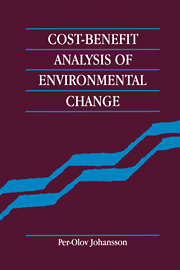Book contents
- Frontmatter
- Contents
- List of figures
- Preface
- 1 Introduction
- 2 Some basic concepts
- 3 Consumer surplus measures
- 4 Valuing public goods: practical methodologies
- 5 General equilibrium cost-benefit rules
- 6 Cost-benefit rules, national income accounts and sustainable development
- 7 Valuation and aggregation: intragenerational and intergenerational issues
- 8 Cost-benefit rules in a risky world
- 9 Valuing changes in access conditions, health risks and information
- 10 Empirical applications
- 11 Policy instruments and international environmental problems
- Notes
- References
- Index
4 - Valuing public goods: practical methodologies
Published online by Cambridge University Press: 15 January 2010
- Frontmatter
- Contents
- List of figures
- Preface
- 1 Introduction
- 2 Some basic concepts
- 3 Consumer surplus measures
- 4 Valuing public goods: practical methodologies
- 5 General equilibrium cost-benefit rules
- 6 Cost-benefit rules, national income accounts and sustainable development
- 7 Valuation and aggregation: intragenerational and intergenerational issues
- 8 Cost-benefit rules in a risky world
- 9 Valuing changes in access conditions, health risks and information
- 10 Empirical applications
- 11 Policy instruments and international environmental problems
- Notes
- References
- Index
Summary
In the case of a commodity that is traded in the market, buyers and sellers reveal their preferences directly through their actions. In the case of public goods and ‘bads’, on the other hand, no such direct revelation mechanism is available. This raises the question of how to overcome the problem of preference revelation. Several different practical methods which can be used to measure the willingness to pay for public goods (bads) have been suggested in the literature. This chapter presents the most frequently used and/or suggested methods: survey techniques, estimation of demand and utility functions, travel cost methods, and hedonic approaches. The chapter ends with an interpretation of willingness-to-pay measures in terms of a demand curve for the private or public good under consideration.
The contingent valuation method
The contingent valuation method (CVM) is the modern name for the survey method (since the answers to a valuation question are contingent upon the particular hypothetical market described to the respondents). The method was first used by Davis (1964) who used questionnaires to estimate the benefits of outdoor recreation. In their excellent book on the contingent valuation method, Mitchell and Carson (1989) list more than 100 US studies based on this technique, while in a recent survey Green et al. (1990) list 26 UK studies. Since these lists were made, a large number of new studies based on the contingent valuation technique have undoubtedly been completed. There is also a large experience with the technique in other countries, e.g. in Scandinavia. The survey technique is thus widely used for the estimation of environmental benefits in particular, and there is a large body of knowledge on the method's advantages and disadvantages.
- Type
- Chapter
- Information
- Cost-Benefit Analysis of Environmental Change , pp. 46 - 64Publisher: Cambridge University PressPrint publication year: 1993



